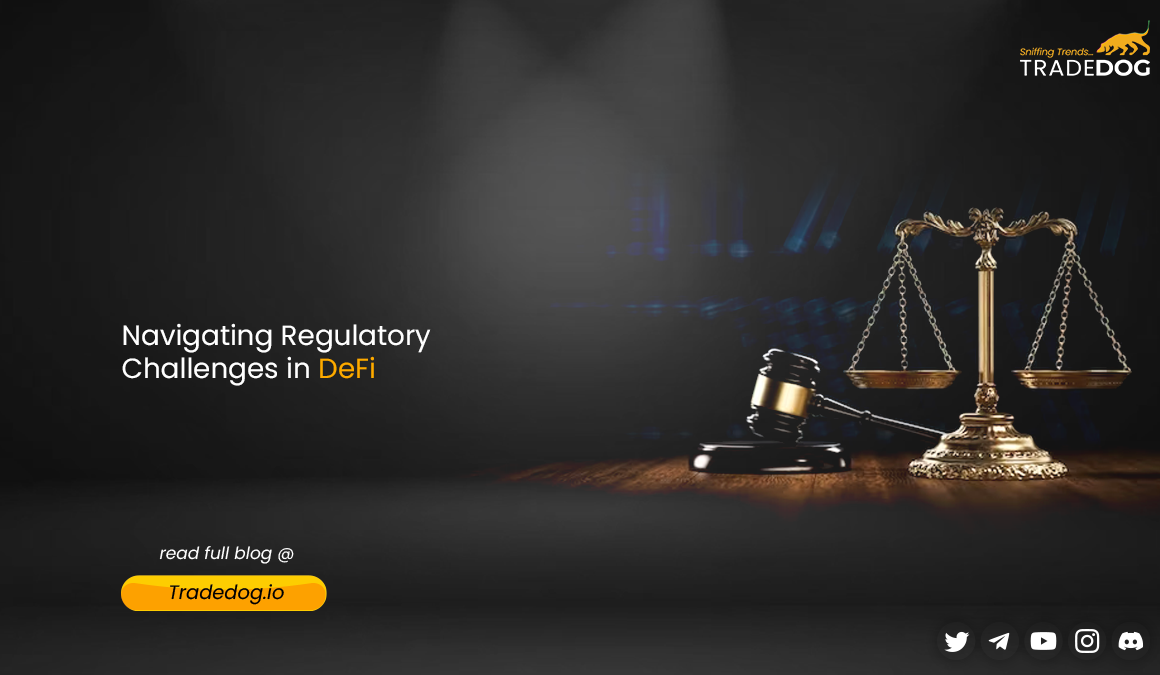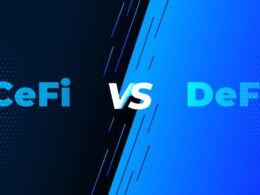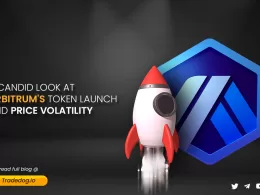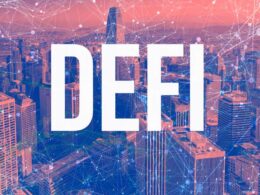Quick Links
Decentralized Finance, or DeFi, is the financial revolution of our time. Picture this: an open, borderless economic playground where traditional barriers crumble, granting you access to a world of financial possibilities with just an internet connection. It’s like a global financial carnival that never sleeps, offering rides on the rollercoaster of innovation, games of risk and reward, and a ticket to financial inclusion for everyone, regardless of their background or location. With a total TVL of approximately USD 60 Billion, DeFi has become one of the prime investment avenues for retail investors. At the same time, these investors are also exposed to severe investment risks due to DeFi’s unregulated structure.
Clear Jurisdiction in DeFi
Challenge
In the world of DeFi, the absence of physical presence and centralized authority raises a perplexing question: Which regulatory jurisdiction should apply? When it comes to traditional finance, we can quickly pinpoint the geographical location of banks, stock exchanges, and financial institutions and, thus, the jurisdiction within which they operate. However, DeFi platforms, built on blockchain technology and smart contracts, transcend such boundaries. They exist in the cloud, accessible to anyone with an internet connection, making it incredibly challenging to determine where they “reside.” This jurisdictional ambiguity poses several thorny issues:
Regulatory Compliance
Different countries have varying regulatory frameworks for financial services, anti-money laundering (AML), counter-terrorism financing (CTF), and investor protection. DeFi projects, operating globally, must grapple with a tangled web of potentially conflicting rules and obligations.
Legal Accountability
When something goes wrong in the DeFi ecosystem, from a smart contract exploit to a fraudulent token offering, establishing legal accountability becomes a perplexing puzzle. Who can be held responsible, and in which court should a case be heard?
Investors and users seek a sense of security and trust in the financial services they use. The absence of clear jurisdiction can erode this trust, deterring potential participants from entering the DeFi space.
.
Solutions
Despite these challenges, the world of DeFi is not without solutions to address the jurisdictional conundrum:
- Global Regulatory Coordination: In a world where DeFi transcends borders, international cooperation among regulatory authorities becomes paramount. Regulatory bodies from different countries can collaborate to establish a unified approach to certain aspects of DeFi, such as AML and CTF regulations. This cooperation can help create a harmonious global regulatory framework that promotes compliance without stifling innovation.
- Regulatory Sandboxes: Imagine a controlled environment where DeFi projects can operate under the watchful eye of regulators. These regulatory sandboxes provide a safe space for experimentation and innovation while regulators closely monitor their activities. This approach enables regulators to gain a deeper understanding of the technology and its potential risks and benefits, all while maintaining a legal framework that safeguards users. Some existing regulatory sandboxes are the FCA sandbox and the RBI Regulatory Sandbox.
- Crypto-Friendly Jurisdictions: Some countries have recognized the transformative potential of DeFi and have chosen to embrace it with open arms. These crypto-friendly jurisdictions offer clear and favorable regulatory environments that attract talent and investment. By providing regulatory clarity and support, they become hubs of DeFi innovation, fostering the growth of the industry. The International Monetary Fund (IMF) is the best example of global crypto jurisdictions.
Compliance and Identity Verification
Challenge
In traditional finance, KYC (Know Your Customer) and AML (Anti-Money Laundering) checks are the gatekeepers that ensure financial institutions can identify and verify their customers. However, in the decentralized realm of DeFi, these traditional methods are like trying to use a map from the 19th century to navigate a modern metropolis. Here’s why:
- Pseudonymity Reigns: DeFi users often operate under pseudonyms or wallet addresses, concealing their true identities. This pseudonymous nature makes it challenging to link a wallet address to a real-world individual for compliance purposes.
- For example, “1A1zP1eP5QGefi2DMPTfTL5SLmv7DivfNa” is a string of letters and numbers and a publicly visible address that anyone can use to send Bitcoin to the owner of the address without revealing their identity.
- Decentralization: DeFi platforms are not governed by centralized entities, which means there’s no one-stop shop for regulatory enforcement. Traditional regulators can’t simply knock on a DeFi company’s door to conduct an audit.
- Privacy Concerns: DeFi users value their privacy and the principle of self-sovereignty over their identity. Forcing them to reveal personal information goes against the core ethos of DeFi.
Solutions
Compliance and identity verification in DeFi are hard to do because they’re like trying to fit a square peg into a round hole. But new ideas are starting to come up to solve this puzzle:
Decentralized Identity (DID)
Imagine a world where you control your identity like a digital passport. DID solutions empower users to manage their identity information and share it with DeFi platforms for verification while preserving their privacy. This approach aligns perfectly with DeFi’s decentralized ethos, giving users the power to decide when and how they reveal their identity. Ethereum Name Service (ENS), WorldCoin, Space ID, and Polygon ID are some of the platforms enabling decentralized identity to users and web3 apps.
Hybrid Approaches
Some DeFi projects are embracing the best of both worlds by combining on-chain pseudonymity with off-chain compliance checks. This hybrid model allows users to engage in DeFi activities pseudonymously on-chain while conducting identity verification checks off-chain when required by regulators.
Regulatory Compliance Tokens
In a stroke of DeFi genius, compliance tokens or NFTs (Non-Fungible Tokens) are emerging as a creative solution. These tokens can represent a user’s compliance with KYC/AML requirements. Users who willingly undergo identity verification can earn these tokens, signaling their commitment to regulatory compliance while still maintaining their pseudonymous on-chain activities.
Smart Contract Auditing
Challenge
Smart contracts are the heart and soul of DeFi applications, responsible for automating transactions and ensuring trust among users. However, they’re not infallible; vulnerabilities and exploits can lurk in their code like hidden traps. Here’s why securing them is a nail-biting challenge:
- Complexity Galore: Smart contracts are often intricate, with complex logic and multiple interactions. This complexity can hide vulnerabilities that even experienced developers might miss.
- Hacker’s Playground: The lure of decentralized finance has attracted both brilliant minds and nefarious actors. Hackers are constantly probing smart contracts for weaknesses to exploit, potentially leading to financial losses for users.
- Trust but Verify: In DeFi, trust is minimized, and verification is maximized. Users rely on the code itself, not intermediaries. Any flaw in the code can have dire consequences, eroding trust in the entire system.
Solutions
In the DeFi world, protecting smart contracts is like making the walls of a castle stronger. These are the steps that DeFi projects take to safeguard their digital fortresses:
Third-Party Audits
Just as a castle wouldn’t trust its defenses to one person, DeFi projects turn to reputable third-party auditing firms to review and audit their smart contracts. These auditors scrutinize the code, looking for vulnerabilities and potential pitfalls. Once identified, these issues can be addressed before deployment. Continuous updates and improvements based on audit findings ensure that smart contracts stay battle-ready. For instance, Immunebytes, Certik, Concensys Diligence, and Hacken.io are third-party audit firms in the DeFi space.
Transparency
In the world of DeFi, transparency is the golden rule. Projects that undergo smart contract audits publish the audit reports and findings for all to see. This transparency not only builds trust but also allows the community and users to assess the security of smart contracts themselves. It’s akin to inviting everyone into the castle to inspect the defenses.
Formal Verification
For those who demand the highest level of security, formal verification methods and tools come into play. This is like hiring a team of mathematical wizards to prove the correctness of smart contracts rigorously. Through mathematical analysis, formal verification can provide an airtight guarantee that the code behaves as intended, leaving no room for vulnerabilities.
Market Manipulation and Fraud
Challenge
DeFi markets are like the Wild West of finance. While this decentralized nature is a breath of fresh air, it also exposes vulnerabilities:
- Market Manipulation: In a world where anyone can participate, and anonymity is cherished, market manipulation becomes an enticing game for some. Price manipulation, pump-and-dump schemes, and flash loans can wreak devastation on the unsuspecting.
- Fraudulent Schemes: DeFi’s open-source nature allows for rapid innovation, but it also opens the door to fraudulent projects and scams. From rug pulls to phishing attacks, users can easily fall victim to cunning schemes.
- Decentralized Challenges: Traditional financial markets have centralized regulators and institutions to deter bad actors. In DeFi, the responsibility falls on the community, making it challenging to swiftly and effectively combat manipulation and fraud.
Solution
In this thrilling marketplace, where innovation knows no bounds and risks abound, DeFi pioneers employ ingenious solutions to ensure the integrity and security of their decentralized realm:
Transparency and Data Feeds
Like watchful sheriffs in the Wild West, DeFi projects turn to decentralized oracles and data feeds to provide accurate and tamper-proof price information. These oracles feed real-world data into smart contracts, reducing the risk of price manipulation and ensuring that financial transactions occur with integrity. Oracles are also prone to price manipulation.
Community Governance
In DeFi, the power of governance resides in the hands of the community. DAOs (Decentralized Autonomous Organizations) and governance tokens are the community’s tools for wielding power. Empowered by these tokens, users can collectively make decisions, take action against malicious actors, and even change the rules of the game when necessary.
Educational Initiatives
In the spirit of empowerment, educational campaigns emerge as the guardian angels of DeFi users. These campaigns raise awareness about common scams and risks in DeFi, educating users on how to protect themselves from fraudsters and manipulators. Knowledge becomes the ultimate shield in this decentralized arena.
Conclusion
The regulatory challenges in the DeFi space are real, but they are not insurmountable. By embracing solutions such as decentralized identity, global coordination, self-regulation, and collaboration with regulatory authorities, the DeFi ecosystem can thrive while addressing concerns related to security, compliance, and fraud. Striking a balance between innovation and compliance is essential to ensure that DeFi continues to evolve as a powerful force in the world of finance, bringing financial freedom and inclusion to all.









